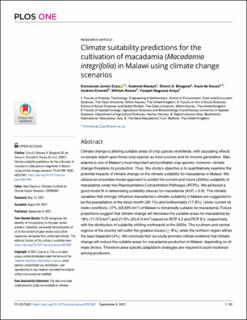| dc.description.abstract | Climate change is altering suitable areas of crop species worldwide, with cascading effects on people reliant upon those crop species as food sources and for income generation. Macadamia is one of Malawi’s most important and profitable crop species; however, climate change threatens its production. Thus, this study’s objective is to quantitatively examine the potential impacts of climate change on the climate suitability for macadamia in Malawi. We utilized an ensemble model approach to predict the current and future (2050s) suitability of macadamia under two Representative Concentration Pathways (RCPs). We achieved a good model fit in determining suitability classes for macadamia (AUC = 0.9). The climatic variables that strongly influence macadamia’s climatic suitability in Malawi are suggested to be the precipitation of the driest month (29.1%) and isothermality (17.3%). Under current climatic conditions, 57% (53,925 km2) of Malawi is climatically suitable for macadamia. Future projections suggest that climate change will decrease the suitable areas for macadamia by 18% (17,015 km2) and 21.6% (20,414 km2) based on RCP 4.5 and RCP 8.5, respectively, with the distribution of suitability shifting northwards in the 2050s. The southern and central regions of the country will suffer the greatest losses (≥ 8%), while the northern region will be the least impacted (4%). We conclude that our study provides critical evidence that climate change will reduce the suitable areas for macadamia production in Malawi, depending on climate drivers. Therefore area-specific adaptation strategies are required to build resilience among producers. | |

